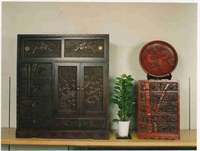

Total:131items
- Pottery & Porcelain (18)
- Lacquerware (4)
- Glasswork (2)
- Wood & Bamboo Work (19)
- Hakone Yosegi Zaiku: Hakone Marquetry
- Boshu Uchiwa: Boshu Fans
- Nikko-bori: Nikko carving
- Sasebo Koma (Sasebo Spinning Top)
- Shimoda Yanimatsu Zaiku (Shimoda Joinery of Oily Pine)
- Echizen Takeningyo (Bamboo Dolls)
- Osaka Senshu Kiri-dansu: Paulownia chest of drawers or wardrobes of Senshu, Osaka
- Kitayama Maruta: Japanese cedar logs
- Yodoegasa: Yodoe umbrella
- Atami Kusu Zaiku: Atami Camphor wood crafts
- Kawatsura Kokeshi Doll
- Itaya Zaiku: Itaya Bark Craft
- Yokohama Classic Furniture
- Hinaga Uchiwa: Hinaga Fan
- Torafu Takezaiku: Tiger Bamboo Work
- Tsuruzaiku: Woven Vine Craft
- Okawa Kumiko: Okawa Kumiko Wood Joinery
- Shuro Houki: Hemp-palm Broom
- Furyumen: Wood Carving Mask
- Leather Work (1)
- Papermaking (13)
- Textile (20)
- Dyeing products (5)
- Masonry (1)
- Metal Work (11)
- Stationery (4)
- Livingware (3)
- Accessory (4)
- Toys & Entertainment (14)
- Interior (2)
- Other crafts (10)

 |
Main Production Site:Tochigi |
 《Characteristics》
《Characteristics》The most impressive characteristic of this woodwork is the use of a unique v-shaped gouge called a “hikkaki.” This is a special tool used by hand with a bent tip. During restoration of the Shinto shrine Nikko Tosho-gu, the triangular shape of the end made it ideal to be utilized as a tool to scrape off the difficult to remove varnish.
At the end of the Edo period, this tool began to be used in carving and was known by the names of “hikkaki” (scratcher), “hikkaki-tou” (scratching blade), and “nikko sankaku-tou” (Nikko triangular blade).
Using a single hikkaki and pulling the blade towards the carver across the wood to produce a hikkaki carving is Nikko carving’s most important feature.
Another characteristic of Nikko carving is the use of plant life as the main theme. The influences of the carving designs at Nikko Tosho-gu are clearly shown with tree peony, chrysanthemum, Japanese apricot and cherry trees often included in the design.
[Tochigi Prefecture Designated Traditional Handicraft]
Source: Nikko-bori Taiken Kyoushitsu Unei Kyougikai (Nikko-bori workshop classroom operation convention) (Tel: 0288-53-0070)
Translation: Catherine Newman

| Materials | Japanese horse chestnut, Japanese Judas tree, Magnolia obovata. |
|---|---|
| Crafting Processes | Nikko carving uses many techniques such as “hikkaki-bori” (scratch-carving), “ukashi-bori” (emboss-carving), “sukashi-bori” (openwork), “maru-bori” (round-carving; U-shaped carving, or 3D carving) and “kago-bori” (basket-carving; outer and inner openwork) but each method uses the same unique v-shaped gouge known as a “hikkaki.” Hikkaki is an edged tool used for the carving of lines. However, unlike normal v-shaped gouges, the edge is bent approximately 60 degrees and brought inwards towards the carver and so became known as “hikkaki” from the Japanese word “hikakku”, meaning “to scratch.” It is believed that it was created during the restoration of the Shinto shrine, Nikko Tosho-gu specifically to scrape off the difficult to remove varnish in some places. This graver is indispensable for the manly, finely chiseled curves of Nikko carving. |
| History | The origin of Nikko carving is not completely clear. However, from the 11th year of the Kan’ei era (1634) until the 13th year (1636), third generation shogun Tokugawa Iemitsu remodeled the main building of Nikko Tosho-gu into the magnificent and splendid building it is today. It is thought that the master craftsmen gathered from all around the country started Nikko carving as a hobby.
Nikko Tosho-gu was built in the 3rd year of the Genna era (1617) but due to the aforementioned Kan’ei era large-scale reconstruction work, the scale of the shrine was completely changed. The number of carpenters involved during this time totaled 1,680,000 with 400,000 of those as carving carpenters. After the reconstruction, several middle or small scale constructions and repairs occurred occasionally and it is thought that a large amount of workmen had a permanent residence at Nikko. A large variety of goods are produced nowadays such as trays, tea tables, cake boxes, small plates, drawers, tables, and flower vase stands. Each work has a handmade style and makes use of the warm, natural feeling of the tree. Nikko carving is a manly craft which requires an apprenticeship and yet despite that, the delicate care and attentiveness shown brings the finished product from a daily object into a dignified work of art. |
| Related URL | https://www.mekke-nikko.com/nikko-kibori |
◆Exhibition / Showcase
Nikko-kibori Sato-kougei Center
Tochigi-ken, Nikko-shi, Tokorono 2848
TEL:0288-53-0070
FAX:0288-53-0310
◆Event Information
A Nikko carving workshop will take place. Please refer to the related URL for more information.



